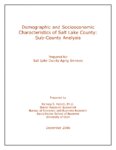TO
1 - 25 of 11
| Title | Date | Subject | Description | ||
|---|---|---|---|---|---|
| 1 |
 |
Profile, Degrees & Majors | The degrees and majors that are offered at the University of the Utah. | ||
| 2 |
 |
Recreation in Utah a profile of the demand for outdoor recreation by Utah residents | 1966-01 | Are recurring problem in planning for economic and industrial development is the lack of sufficient basic data upon which sound planning decisions may be made. One of the industry areas in which the lack of basic data for planning is conspicuous by its scarcity is outdoor recreation. Yet the outdoor... | |
| 3 |
 |
Sunnyside Special Tar Sand Area site specific analysis Sunnyside no. 12 tract: Moab District, Price River Resource Area | 1983-03 | Sunnyside special tar sand area; site specific analysis; Sunnyside no. 12 tract; tar sand extraction; STSA | The Sunnyside No. 12 Tract is in the north-central part of the Sunnyside Special Tar Sand Area (STSA) in Carbon County, Utah. The tract is located about 33 miles east of Price, Utah (See Maps 1 and 2 in Appendix I). The legal description and ownership are shown in Table 1. |
| 4 |
 |
Barriers to industrial development in Utah's portion of the four corners region | 1970-06-01 | Utah's portion of the Four Corners area is composed of the 21 counties which are south and/or east of Salt Lake County. The Utah Four Corners area covers 65,000 square miles which is approximately 80 percent of the state. The are a has a population of 274,500 dispersed throughout the region in a ver... | |
| 5 |
 |
Utah data guide a newsletter for data users | 1998 | Utah's seven associations of government (AOGs)1 have produced these city and unincorporated area population projections for each year from 1997 through 2002 and for the years 2010 and 2020. These are consistent with the county population projections produced by the Governor's Office of Planning and ... | |
| 6 |
 |
Report on Utah's second year of planning for the four corners regional commission | 1970-09 | scope of work contained in Article I set forth five specific program elements on which services were to be rendered. These were: 1. Continue to develop and refine criteria and evaluation procedures for assigning priorities to projects submitted for funding by the Four Corners Regional Commission.... | |
| 7 |
 |
Basin-wide evaluation of the uppermost Green River Formation's oil-shale resource, Uinta Basin, Utah and Colorado | 2008 | Green River; Uinta Basin; Utah; Colorado; Crude oil; Green River Formation; Oil; Gas; Oil yield; Oil shale; Oil-shale thickness; Mahogany zone; R-7; Parachute Creek Member; Richness grade; Uintah County; Salt Lake Base Line and Meridian; BLM; U.S. Bureau of Land Management | Due to the recent increase in crude oil prices and concerns over diminishing conventional reserves, the Utah Geological Survey has reexamined the Uinta Basin's oil-shale resource, primarily in the Mahogany zone of the Green River Formation. Past assessments, the first conducted in 1964 and subsequen... |
| 8 |
 |
Multi-county regions in Utah | 1970-03 | The publication of this report was made possible through the financial assistance of the Four Corners Regional Commission with coordination by the State Planning Coordinator's Office, State of Utah. The statements, findings, conclusions, recommendations, and other data in this report are solely thos... | |
| 9 |
 |
Recreation in Utah a profile of the demand for outdoor recreation by out-of-state travelers to Utah | 1967-12 | A recurring problem when planning for economic and industrial development is the lack of sufficient basic data on which sound planning decisions can be based. One of the industry areas in which this lack of basic data has been conspicuous is the area of the out-of-state visitors' demand for Utah's o... | |
| 10 |
 |
Demographic and socioeconomic characteristics of Salt Lake County: sub-county analysis | 2006-12 | Salt Lake County; Projections; Estimates; Aging population; Baby boom; Utah; Salt Lake Aging Services; Kennecott Land | This paper is an examination of the shifting geographic distribution of the population within Salt Lake County over time as well as an analysis of the spatial distribution of its demographic and socioeconomic characteristics. It builds on the county-level analysis included in a separate section of t... |
| 11 |
 |
Growth issues in Utah: facts, fallacies, and recommendations for quality growth | 1999-10 | The Sutherland Institute is an independent, non-profit, non-partisan Utah pub-He policy research and educational organization. The Institute seeks to create effective solutions to Utah's public policy problems. State and local issues are its primary concern. The Institute seeks to positively affect ... |
1 - 25 of 11
